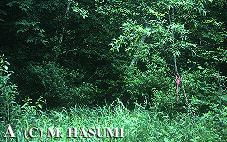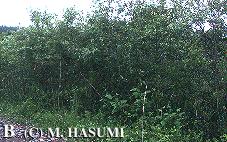

 |
 |
(A) Habitat R1: a pond with 10.5 x 4.1 m area (52 cm deep), including approximately 20 egg-clusters of R. pirica, having the developmental stages from neural-fold to tail-bud, near the surface of the water, at the time of examination on 10 May 1997 (air temperature 15.3 C, pH 5.90). Water temperatures varied from 2.8 C (at 50 cm depth) to 14.5 C (at 0 cm depth), due to the frozen soil at the bottom of the pond.
On 8 June, I collected 24 tadpoles with the developmental stage of 26 (mean = 26.0, SD = 0) and body masses of 0.03-0.13 g (mean = 0.079 g, SD = 0.025) from the pond (65 cm deep; air temperature 11.2 C, pH 5.84). Water temperatures varied from 6.1 C (at 30 cm depth) to 8.7 C (at 0 cm depth).
On 8 July, I collected 38 tadpoles with the developmental stages of 26-32 (mean = 28.7, SD = 1.7) and body masses of 0.05-0.38 g (mean = 0.201 g, SD = 0.074) from the pond (62 cm deep; air temperature 16.9 C, pH 6.04). Water temperatures varied from 13.0 C (at 50 cm depth) to 15.0 C (at 0 cm depth).
On 10 August, I collected 24 tadpoles with the developmental stages of 28-37 (mean = 32.9, SD = 2.5) and body masses of 0.14-0.68 g (mean = 0.458 g, SD = 0.164) from the pond (63 cm deep; air temperature 14.7 C, pH 5.69). Water temperatures varied from 12.9 C (at 0 cm depth) to 13.9 C (at 60 cm depth).
No predator was found in the pond throughout these examination periods.
(B) Habitat R3: a pond with 42.7 x 3.5 m area (55 cm deep), including approximately 10 egg-clusters of R. pirica, having the developmental stages from neural-fold to tail-bud, near the surface of the water, at the time of examination on 11 May 1997 (air temperature 4.2 C, pH 5.98). Water temperatures varied from 6.6 C (at 0 cm depth) to 7.4 C (at 50 cm depth).
On 8 June, I collected 7 tadpoles with the developmental stage of 26 (mean = 26.0, SD = 0) and body masses of 0.11-0.19 g (mean = 0.141 g, SD = 0.025) from the pond (64 cm deep; air temperature 16.5 C, pH 5.80). Water temperatures varied from 9.5 C (at 60 cm depth) to 19.9 C (at 0 cm depth).
On 8 July, I collected 5 tadpoles with the developmental stages of 32-35 (mean = 33.2, SD = 1.3) and body masses of 0.54-1.25 g (mean = 0.780 g, SD = 0.289) from the pond (64 cm deep; air temperature 21.4 C, pH 5.80). Water temperatures varied from 13.2 C (at 60 cm depth) to 16.0 C (at 0 cm depth).
On 10 August, I did not collect any tadpole from the pond (73 cm deep; air temperature 17.7 C, pH 5.53). Water temperatures varied from 15.1 C (at 0, 10, 20, 30, and 40 cm depths) to 15.9 C (at 60 and 70 cm depths).
In the pond, there were 1 larva of Enallagma boresle circulatum (Coenagrionidae) and 1 larva of Limnephilus sp. (Limnephilidae) on 8 June, 2 adults and 5 juveniles of Pungitius tymensis (Gasterosteidae) and 2 larvae of Dytiscidae on 8 July, 2 juveniles of P. tymensis and 2 adult males of Dytiscus dauricus (Dytiscidae) on 10 August, each resulted from 5-time collections by dip-netting within the radius of 3 m from the place where egg-clusters of R. pirica had been accumulated. Among these, species of Coenagrionidae and Dytiscidae were evidently predators against tadpoles of R. pirica.
High water temperatures and high predation pressures presumably enhanced the growth of tadpoles in the R3 habitat.
Hasumi, M., and F. Kanda. 1998. Amphibian fauna of Bekambeushi Marsh, Japan. Journal of Environmental Education 1(1): 165-169. (In Japanese)
Hasumi, M., F. Kanda, and H. Fujitsuka. 1998. Larval growth environment of the frog (Rana pirica) in Bekambeushi Marsh, Japan. Journal of Environmental Education 1(1): 171-174. (In Japanese)